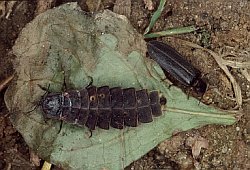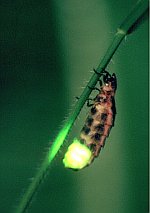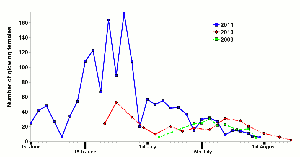Glow-worms at St Mary's churchyard
A colony of glow-worms has been established in St Mary's churchyard since at least before WWII. In order to ensure this colony continues to thrive O.B.S. started monitoring its population size in 2009 and communicating with the church warden to encourage best management practices for glow-worms.
What are glow-worms?
Glow-worms (scientific name, Lampyris noctiluca) are beetles. Their name refers to the 'worm-like' appearance of the wingless females and their ability to produce light. The females grow up to 25 mm long while the smaller but fully winged males grow up to 18 mm. Larvae hatch from the egg in late summer and live for about 15 months during which they eat snails and slugs and moult multiple times as they grow bigger. In the early summer of their second year they metamorphose into adults. The adults live only a few weeks during the summer when they mate and females lay eggs.

Where do they live?
Glow-worms like chalky or limestone areas and prefer open grassland and hedges where snails and slugs are abundant. They are rarely found on "improved" agricultural land.
Larvae live in sheltered places under rocks and wood, or hide in undergrowth during the day. They are nocturnal and are most active during moist conditions. They hibernate over the winter.
The female adult beetles also hide in the undergrowth during the day. At night time they climb up grass stalks and glow while males fly around attracted to the characteristic glow.
How and why do they glow?
Normally it is the virgin female beetle that glows and attracts males for mating. Peak glowing time is June and July but can last from late May to September. Females displays seem to be triggered by falling light intensity level. Females usually display for two or three hours and if after that time they have not attracted a mate they stop glowing and retreat into the grass until the following night.
Larvae can glow too, but with much fainter light and sometimes as pulsating light rather than as a continuous glow.
The light is a form of bioluminescence; a molecule called luciferin is oxidised to produce oxyluciferin, and as it oxidises it produces the yellow-green glow that the glow-worms are famous for.
Survey method
The survey was carried out at night in the summers of 2009, 2010 and 2011 in St Mary's churchyard and in the adjacent parish cemetery on Kingsclere Road. In June-July volunteers walked throughout the site and recorded on a map all glowing females seen.
Survey results (summary)
 In 2009 and 2010 we probably missed the height of the glowing season and therefore recorded modest numbers of glowing females with a maximum of 31 females in 2009 (17th July) and 53 females in 2010 (23rd June). In 2011 we started much earlier and saw the number of glowing females peak at 173 on 25th June. View the full size graph here.
In 2009 and 2010 we probably missed the height of the glowing season and therefore recorded modest numbers of glowing females with a maximum of 31 females in 2009 (17th July) and 53 females in 2010 (23rd June). In 2011 we started much earlier and saw the number of glowing females peak at 173 on 25th June. View the full size graph here.
In total we estimate we recorded 59 different individual females in 2009, 160 in 2010 and 687 in 2011. Most females displayed for one night only but many displayed several nights in a row, some for up to over 3 weeks. Glowing females were found throughout most of the site, in the churchyard East and North of the church (including in the steep verge on the Eastern side) and also in the parish cemetery (in smaller numbers). Click to view a map showing the location of all the glow-worms recorded in 2011.
Overall, the glow-worm colony in Overton seemed sound. O.B.S. will continue to survey and liaise with the church warden to help maintain a healthy population there.
A more comprehensive report is available from our online library in the 'resources' section of this web site.
More information
For additional information about the glow-worm in the UK visit the UK Glow worm Survey web site.
There are two very good books about the glow-worm:
- The Glow-worm by John Tyler (available from John Tyler's web site)
- The Secret Life of Glow-worms — Including the Lesser Glow-worm by John Horne (available from NHBS)
Notes
A printable glow-worm fact sheet is available to download from our online library in the 'resources' section of this web site.
All pictures © John Tyler and Robin Scagell (www.glowworms.org.uk).
